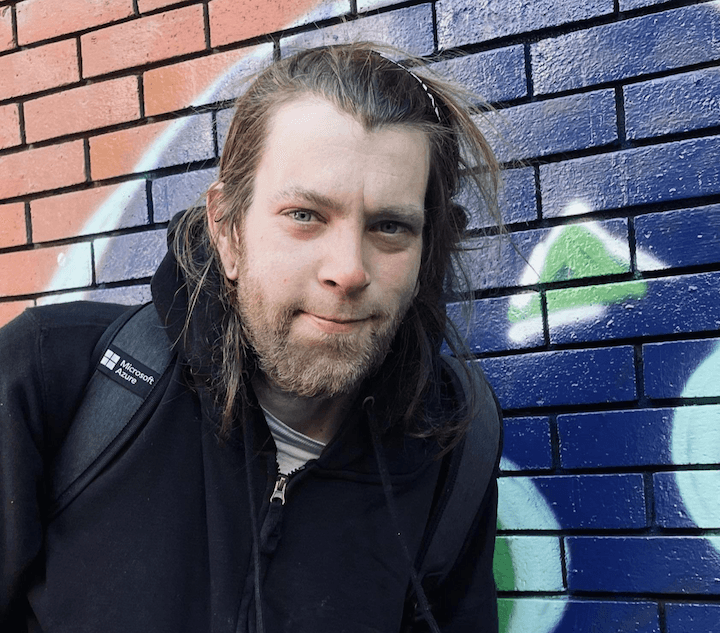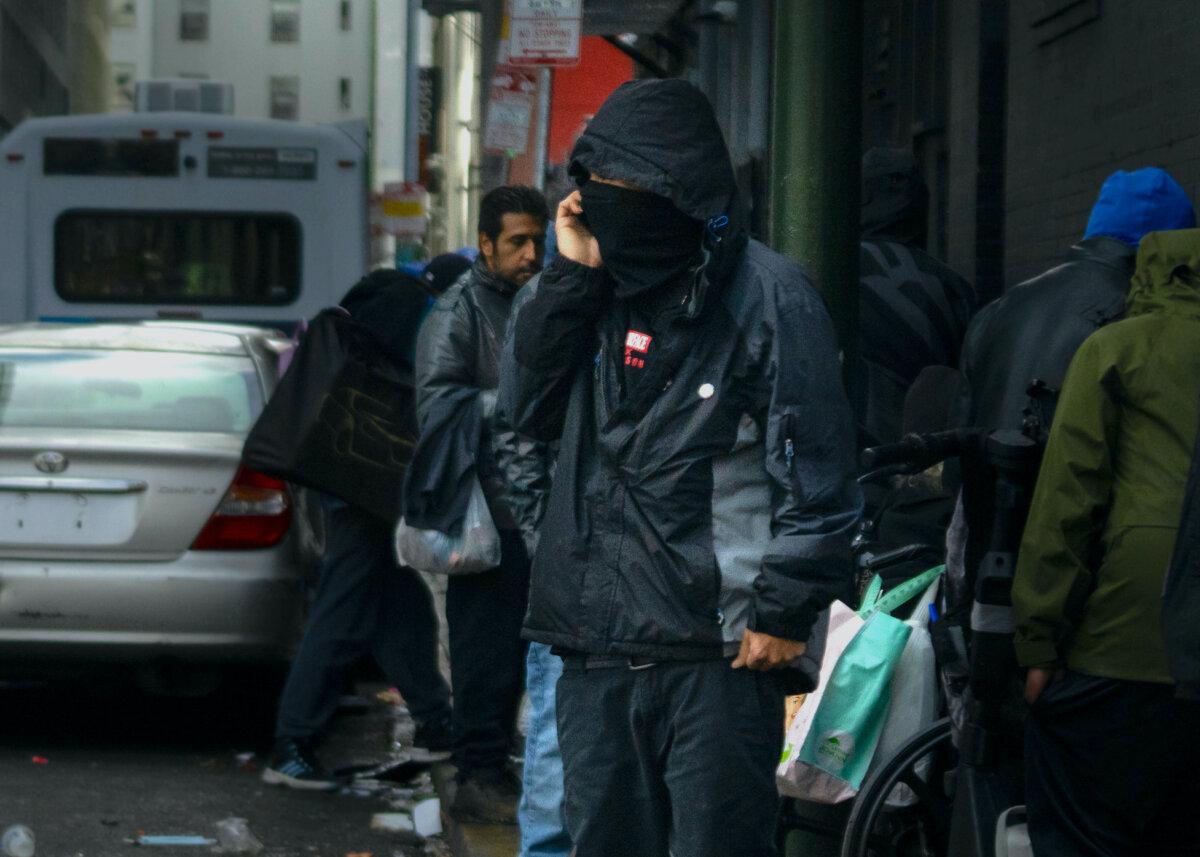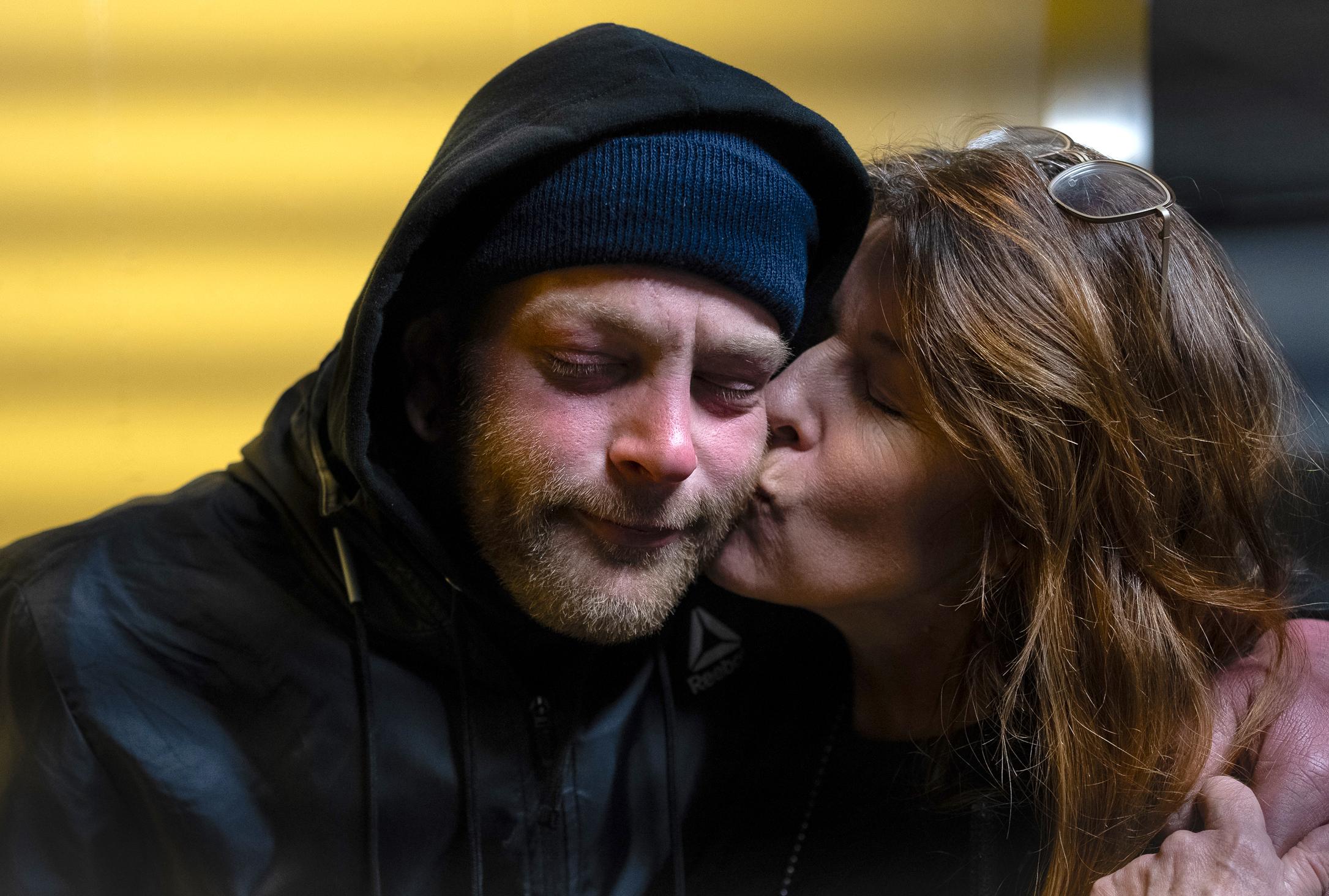Jackie Berlin embraces her son Corey who is homeless and addicted to fentanyln San Francisco, Calif., on Feb. 22, 2023. (John Fredricks/The Epoch Times)
Jacqui Berlinn makes her way through a crowd of ski mask-clad drug dealers on a street corner in San Francisco. She’s looking for her son, Corey, who is homeless and addicted to fentanyl.
In the city’s infamous
Tenderloin district, dealers brazenly sell their illicit wares in open-air drug markets.
She walks for hours on a cold, windy night in February, passing makeshift shelters and tents on pipe-and-needle-strewn sidewalks along her way to find him. In the shadows of City Hall, she approaches a group of homeless young men huddled at an encampment as a drug dealer patrols the area.
The
dealer—armed with a baseball bat—is easy to spot in his signature balaclava and black garb. He’s straddling a bicycle, holding the handlebars with one hand. In the other, he grips the bat, resting its head on the concrete and rocking it back and forth to make sure it’s seen. He’s ready to move as he keeps a wary eye on the middle-aged mom.
She holds out her phone to show the men a picture of Corey, who is in his mid-30s. They recognize him from the image but say they haven’t seen him around lately. They tell Ms. Berlinn she’s not alone—a lot of people come to the Tenderloin in search of their lost loved ones.
In a motherly manner, Ms. Berlinn reaches out, gently adjusting the brim of a young man’s hat to see his eyes. He reminds her of Corey. She offers to help him and two other men when they’re ready to get off the streets and warns them about the surge in fentanyl overdoses.
But these men know the risks too well.
“China is killing us,” said one of them who was sporting a long coat and Alice-In-Wonderland-style Mad-Hatter top hat. “Russia did it to England and now China is doing it to us.”
Fentanyl is known to come to the United States from China through Mexico, according to the U.S. Drug Enforcement Administration. The lethal synthetic opioid is up to
100 times more potent than morphine and 50 times more potent than heroin.
Ms. Berlinn thanks the men for their time and continues her quest.

Jacqui Berlinn looks for her son Corey who is homeless and addicted to fentanyl in San Francisco, Calif., on Feb. 22, 2023. (John Fredricks/The Epoch Times)
Meeting Corey
As she treks back toward the train station, Ms. Berlinn answers her phone. It’s Corey. He agrees to talk to The Epoch Times about the conditions on the streets and his struggle with addiction. He has lived on the streets of the Tenderloin for years.Ms. Berlinn finds him near the entrance to the subway station by a row of pay phones. He is hunched over with a backpack slung across his shoulders, clutching the waist of his jeans.
“My belt is broken,” he said.
But he’s in luck. An Epoch Times photojournalist offers Corey his belt, which he graciously accepts.
Ms. Berlinn reaches over her son’s backpack, pulling him closer as the two descend an escalator to a Whole Foods Market where she buys some roast beef from the delicatessen and finds a table where she coaxes Corey to eat. But he’s more exhausted than hungry and struggles to stay awake as he tells the story of his addiction.
The Whole Foods store, at 8th Street and Market Street, which had tight security at the time, has since closed its doors. In April, after just one year of operation, the company shut down the store over concerns for worker safety, amid widespread complaints of retail theft and reports of a 30-year-old man who died from a fentanyl and methamphetamine overdose in one of the store’s locked and guarded restrooms.

Jacqui Berlinn walks with her son Corey who is homeless and addicted to fentanyl in San Francisco, Calif., on Feb. 22, 2023. (John Fredricks/The Epoch Times)
Tale of Addiction
Like many hardcore drug users, Corey started smoking marijuana before experimenting with hard drugs.“I started smoking pot when I was like 15 or 16, and then started using heroin when I was 22,” he said.
He kicked heroin for 10 months. But, when he relapsed, he was tricked by dealers who mixed much cheaper fentanyl with the heroin, and he got hooked on the much stronger synthetic opioid.
“They’re both the hardcore drugs. They’re both very bad and very dangerous, especially for people that don’t have tolerances for them,” he said. “Any drug is going to be hard to quit. It’s hard to say which one is more difficult.”
Because Corey smokes fentanyl, he gets cravings every two to three hours, but says he can go without a fix for about eight to 12 hours before he starts to feel “dopesick.”
The sickness leaves him so weak that “it’s hard to even get up and move,” he said.
Addicts fear withdrawal symptoms because once they’re dopesick it’s difficult for them to find the strength to seek out dealers to get more drugs just to function, Ms. Berlinn said.
“So, you’re not really getting high, you’re keeping yourself from feeling sick because then you’re in trouble,” she said.
But, she said, medications, such as methadone or Suboxone, can ease the intensity of withdrawal symptoms.
“We have the ability to help any addict get through that,” she said.
Withdrawals start with mild anxiety and get more extreme as the hours pass. Then, physical symptoms such as a runny nose and watery eyes progress to body aches, and restless leg syndrome, Corey said.
“You can’t stop kicking your legs. That’s why they call it kicking,” he said. “Your skin doesn’t feel normal, like it’s crawling or it’s too tight.”
Physical withdrawal from fentanyl is similar to kicking heroin, but “a little bit worse and it comes on a little bit faster,” he said.
Even after the first few weeks, addicts continue to go through physical pain and mental anguish, Ms. Berlinn said.
“It’s a lifelong battle, especially for people who have been using for years and years,” he said.
That’s why alcoholics and addicts introduce themselves as such at Narcotics Anonymous and Alcoholics Anonymous meetings even after they’ve been clean and sober for years, he said.
“It’s still an everyday fight,” Corey said. “That’s really the hardest part I think.”
Recovery means “starting to rebuild your life without feeling numb anymore,” but most addicts who’ve been on the street as long as Corey don’t have the skills to do that and need more support, Ms. Berlinn said.
Even though Corey knows he can withstand the agony of withdrawal, the thought of staying clean and sober while trying to pick up the pieces of his shattered life is daunting. Remaining a drug addict is a choice that, for him, is more comfortable than living a clean-and-sober lifestyle, he said.
“I don’t like [being sober]. It’s not appealing to me. When I’m clean, it doesn’t give me the same satisfaction as when I’m living this lifestyle,” he said. “It’s almost like you’re a completely different person because your emotions and your mindset—your likes, your dislikes—everything changes when you’re sober after using and vice-versa.”

Jacqui Berlinn and her son Corey in an older photo. (Courtesy of Jacqui Berlinn)

Jacqui Berlinn's son Corey in a more recent photo. (Courtesy of Jacqui Berlinn)
Still, he knows every day on the streets is a deadly game of chance, and the reward of recovery means “being reunited with my family.”
On the street, it’s not easy to stay in contact with family and nearly impossible to keep a cell phone, he said.
“It’s hard to call anyone out here a friend,” he said. “You can blink, and your cell phone will be gone. I can’t even make it through one pay period. I’ve had so many phones, and people are always ‘nodding off’ and leaving themselves vulnerable.”
‘Pleasure Island’
Corey likens San Francisco to “Pleasure Island,” the cursed island in the classic story of Pinocchio where lost boys looking for fun eventually turn into donkeys.In the Tenderloin, most addicts are comfortable using hard drugs regardless of who is around to see them, because “police have a high tolerance for people using,” he said.
Corey makes it a point not to use drugs in front of children and prefers to be alone when he gets high.
“It’s hard to escape,” he said. “I personally don’t like to be in large groups using. I don’t like using in front of the people that don’t do it, and I really don’t like to use in front of people that do do it, but I find myself doing both.”
At a table in the food court, Corey removes a backpack slung over his shoulders and displays the items of a “harm reduction kit” he got from one of the organizations that distribute them free to addicts in the neighborhood.
“This is the Narcan. That is the injectable one,” he said, as he displayed the items on a table in the food court. “They come with syringes.”
The contents of the kits vary, ranging from clean syringes to foil and pipes and other drug paraphernalia. The various outreach groups that provide them say the naloxone—an overdose reversal drug more commonly known by the brand name Narcan—and information in the kits help prevent overdose and death. The syringes and testing kits for sexually transmitted infections, including HIV, are designed to prevent the spread of disease. Some also contain needle disposal containers.
Corey knows most addicts will get high regardless of whether they’ve got clean needles or supplies.
“If they want to use, they’re going to use anyway,” he said.

A harm reduction kit featuring syringes and naloxone sits on a table in San Francisco, Calif., on Feb. 22, 2023. (John Fredricks/The Epoch Times)
The groups that hand out the kits are “strictly trying to keep people safe” and don’t want to be seen as “tricking” or pressuring drug users to get clean, because “people don’t like that,” he said.
But like it or not, his mother believes “harm reduction kits” enable drug users to keep using, and that outreach groups should offer easier access to counseling and detox facilities.
While she agrees clean needles help reduce the exchange of blood to curb disease, handing out pipes and foil only makes it easier for addicts to smoke fentanyl, rather than inject it, as well as crack cocaine and other drugs.
“They’re handing them out like crazy. I think it just normalizes it and enables them,” she said. “To give them pipes and foil doesn’t make sense to me. They’ve gone overboard.”
The ‘Dark Reality’
Ms. Berlinn co-founded the group
Mothers Against Drug Addiction and Deaths to help save her own son and others like him, she said. Though she was once ashamed to tell the story of his addiction, she eventually realized that sweeping the problem under the rug wasn’t helping her or her son.
Though burdened with sorrow, it eases her mind to know she’s doing all she can to fight against the drug epidemic and a system that enables it, and that means telling and re-telling Corey’s story.
Corey is one of more than
126,000 homeless people in California—many who struggle with drug addiction.
“It’s heart-wrenching and exhausting to relive the pain, but it’s so necessary for people to know and understand,” she said. “There is no way to sugarcoat the dark reality of America’s drug epidemic.”
While true stories of addiction are depressing and disturbing, they must be told to end the apathy, affect change, and stop the flow fentanyl and other deadly drugs into the U.S., she said.

Jacqui Berlinn walks with her son Corey who is homeless and addicted to fentanyl, in San Francisco, Calif., on Feb. 22, 2023. (John Fredricks/The Epoch Times)
Detox and Rehab
With an acute shortage of detox beds in San Francisco, finding one in a facility that provides detox medications is even more challenging, Corey said.“Most of the time, they just give you a bed,” he said.
“So, it’s just lay there and be miserable,” said Ms. Berlinn.
Drug users who do get into a detox bed in the Tenderloin must—once they’re released as newly recovering addicts—run the gauntlet of open-air drug markets to a rehab facility, Ms. Berlinn said.
“They have to go right through the area where all the people are using and all the dealers are selling,” she said. “It’s horrible.”
Detox centers are supposed to help medically stabilize patients to minimize withdrawal symptoms and help addicts transition to rehab, she said, stressing that “detox” and “rehab” programs differ substantially even though the terms are often used interchangeably.
Detoxification is the first step in getting clean, while substance abuse rehabilitation, or rehab, is the ongoing social psychological therapy of staying clean.
The problem is, many rehab facilities require drug users to stay clean for a week or more before they can get into a program—but that’s a tall order for any addict, especially for those living on the street, Corey said.
Most addicts simply don’t have the inner strength and determination it takes to cope with withdrawal symptoms while trying to navigate their way through the treatment process without clear direction, support, and guidance, he said.
“I don’t know what people are supposed to do if there’s no detox stage before these programs. You can’t just quit cold turkey on this stuff,” he said. “Besides the physical nightmare they go through, it’s a very extreme and almost traumatizing mental experience. You don’t feel like yourself at all, and you don’t feel comfortable around people. There are really no words to explain it, and you really can’t understand unless you’ve been through it.”
The chances of a dopesick addict staying clean with dealers all around, amid the elements of wind, cold, rain, and noise, along with the chaos and violence on the streets, are slim, he said.
Housing Hassle
Corey said he has tried for more than a year to get housing in a single resident occupancy hotel room, known as an SRO, but hasn’t had any luck.“A big part of it is my failure to take the steps that I need to take to accomplish getting housing. I need to get my ID,” he said.
Aside from the risk of going through withdrawal while standing in line at the DMV for an ID to show up in the mail, he’s heard a lot of people don’t even receive their IDs.
“I don’t have an address, so I’d have to use someone else’s address, and I’ve heard people don’t even get their IDs,” he said. “And then, even if I do get my ID after all that, it is very likely that it’s going to be stolen or lost very, very quickly.”
As Corey lays his head down on the food court table, mother and son agree it’s getting late, and the two decide to go home—Jacqui back to the suburbs and Corey back to the streets. But before they do, Corey leads his mom a few blocks down the street to a clinic where he stops for a few minutes to get methadone.
Reluctant to say good-bye, Ms. Berlinn hugs Corey tightly, kisses him on the cheek and heads back to her car as Corey walks away, fading back into the grips of the Tenderloin.

An alleged drug dealer stands near a row of drug addicts in San Francisco, Calif., on Feb. 23, 2023. (John Fredricks/The Epoch Times)
Glimmer of Hope
Ms. Berlinn has also helped form a new group called
North America Recovers, a nonpartisan coalition of more than 20 American and Canadian community leaders, parents of the homeless, and recovering addicts seeking federal, state, and local actions that “support addiction recovery—not addiction enablement,” including treating mental illness.
In search of hope, she traveled to Los Angeles in July where she met Rev. Andy Bales, who ran the Union Rescue Mission in Skid Row, another notorious drug-infested area of California. Mr. Bales is set to retire at the end of this year, after nearly two decades spent serving Skid Row’s homeless and destitute.
“They’re amazing at what they do,” she said of the mission.
While she was in Los Angeles, Corey seemed to be doing better and called her several times.
“He told me that he asked the people at the methadone clinic to make him a list of rehabs outside of San Francisco County that accept people using methadone because he wanted to get well and get sober,” she said.
But, in late November, Ms. Berlinn said she hadn’t heard much from Corey, though he sent her a happy birthday wish in a text message a couple weeks ago.
While the fentanyl epidemic may not affect everybody directly, such as the loss or hurt of a loved one, everyone feels the indirect impact of rising crime and decreased public safety, she said.
“The new meth that’s on the street is making people completely psychotic. It makes them out of their minds. I feel like the way the drugs are coming into this country, we’re just being undermined, and our citizens are being poisoned and terrorized,” she said. “It’s just awful.”
Ms. Berlinn has called for the repeal of Proposition 47, which has prevented police from arresting addicts for certain drug and property crimes, because, she said, at least when her son was in jail, she didn’t worry as much about the ever-looming threat of a fatal overdose.
“When my son got arrested for little crimes, that’s when he would get some moments of sobriety,” she said. “I’d be like, ‘Thank God, he’s in jail!’ And, when he got out, he would be willing to try [to quit] because he had his wits about him. He could think straight because he wasn’t full of drugs.”
Recently Corey almost lost his thumb to fentanyl laced with xylazine, an animal tranquilizer known as the street “
tranq.”
The deadly drug mixture also left her son feeling paralyzed, and “unable to move” in freezing weather. Luckily, a Good Samaritan called an ambulance and Corey was taken to the hospital and treated for hypothermia, she said.
Treatment On Demand
More than 15 years since San Francisco voters approved Proposition T, enacting the Treatment on Demand Act, which required the city and county to provide treatment for people with substance use disorders based on the level of demand, Ms. Berlinn says the city still has a long way to go achieve that goal.Access to detox beds and effective treatment programs addicts need to get clean—and stay clean—are woefully inadequate, she said.
As of Dec. 13, the San Francisco Department of Public Health
reported that for Medi-Cal patients, there were seven detox beds available for men and 12 for women, out of a total of 58. Short-term stay resident treatment beds available were four for men and nine for women, out of 246, while there were three beds for men and three for women in residential step-down programs, out of 271.
The city also offers “street medicine,” such as “overdose follow-up and linkage to harm reduction services,” substance use treatment, and medications such as low-threshold buprenorphine, and weekly clinics at harm reduction sites and drop-in centers.
The department’s 2021–2022 Treatment on Demand
report released to the Board of Supervisors in February states that in the 2021–22 fiscal year, 4,534 people were admitted for substance abuse under Medi-Cal. Of those, 64 percent were homeless and 46 percent received a mental health service at the same time. The report also notes admissions for fentanyl addiction have increased.
The most recent
homeless count in San Francisco from 2022 found 4,397 unsheltered people living on the streets of the city, with 52 percent admitting to alcohol and drug use.

San Francisco city hall in San Francisco, Calif., on Feb. 23, 2023. (John Fredricks/The Epoch Times)
Ms. Berlinn has met with San Francisco Mayor London Breed and remains hopeful the city will take bolder action to remedy the drug problem.
“We believe they need to close the open-air drug markets. They need to hold people accountable—not lock everybody up—but they can’t be out there just selling drugs when people are dying, and then they’re right back out there selling.”
Neither the San Francisco Police Department Tenderloin station nor Mayor Breed’s office responded to requests for comment.
Mandatory Treatment
Ms. Berlinn believes mandatory treatment programs are needed, because too often the long wait for addicts to hit rock bottom ends in fatal overdoses.California
Senate Bill 43, a recently passed state law, may provide a glimmer of hope. Set to take effect on Jan. 1, 2026, the new law will allow authorities to detain people with untreated mental illness and addiction issues against their will and force them into treatment.
The bill, passed unanimously by the state Senate and Assembly, aims to reform the state’s conservatorship system by expanding the definition of “gravely disabled” to include those who are unable to provide basic needs, such as food, clothing, and shelter for themselves due to an untreated mental illness or substance use.
Under current California law, police can’t apprehend drug addicts living on the streets and take them to mental health facilities for treatment unless they pose an acute risk of harm to themselves or others, such as an attempted suicide or a violent psychotic episode, for example. And, even so, they can only be detained for up to 72 hours while awaiting assessment.
The new law is designed to make it easier for authorities to provide care to people with untreated mental illness or addictions to alcohol and drugs—many who are homeless—and no longer requires a co-occurring mental health disorder to do so.
California Gov. Gavin Newsom said the state is “undertaking a major overhaul” of the mental health system, when he
signed the bill into law on Oct. 10.
“The mental health crisis affects us all, and people who need the most help have been too often overlooked. We are working to ensure no one falls through the cracks, and that people get the help they need and the respect they deserve,” he said.
J.J. Smith, a San Francisco resident whose brother, Rodney, died alone in hotel room last year from a fentanyl overdose after getting a harm reduction kit, walks the Tenderloin almost daily offering help to addicts and encouraging them to get off the street.
Mr. Smith told The Epoch Times groups such as the American Civil Liberties Union, which oppose the criminal prohibition of illicit drugs and mandatory treatment, aren’t making it easier for police to get people into detox and rehab facilities.
“You’ve got all these organizations ... pushing a hard line saying that it’s normal,” he said. “You’ve got the ACLU saying people have right to use drugs if they want to, and you cannot take them to jail because they want to use drugs.”
It used to be a crime to have paraphernalia, he said, but now cities are funding nonprofit groups, non-government organizations known as NGOs, to hand out “
death supplies” to addicts, and the police can’t arrest anyone for it, he said.
John Fredricks contributed to this report.





















